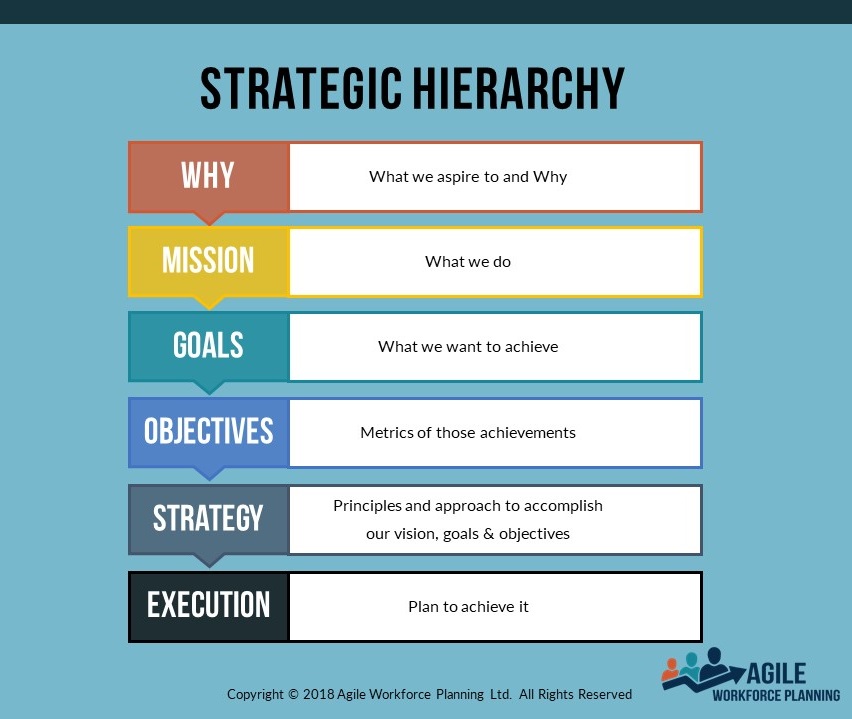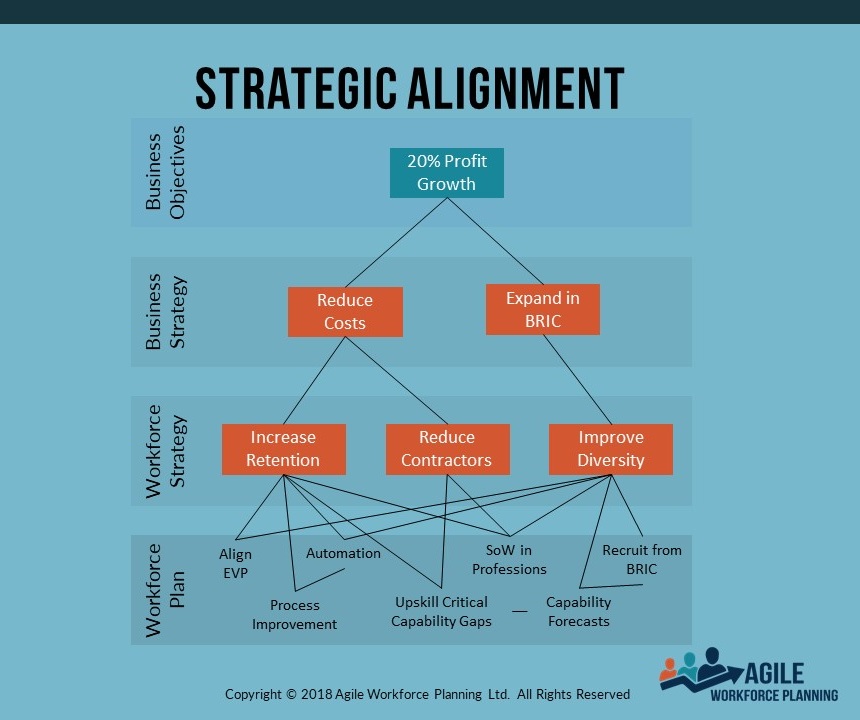I was recently coaching a mentee in strategic workforce planning and we were discussing the format for a workforce plan and the elements to include within in. This developed into a wider conversation around the difference between workforce plans and workforce strategies and how these are often confused and conflated when created by HR departments. This is not to blame HR; the words ‘strategy’ and ‘plan’ are often used interchangeably within business.
Strategic Alignment
To understand where these concepts fit, we must start with the broader concept of strategic alignment. This is the vertical linking of the following concepts:
Why. Why did the organisation come into existence, why does it continue to exist. This is the most critical starting point of an organisation and would commend to you Sinek (2011) and his subsequent work on the importance of getting this right. The ‘why’ is most often framed as one of two things:
- Vision is an imagined future state of what the organisation, the marketplace or the world will look like; for example my personal vision is “engaged people connected with meaningful work”.
- Purpose is the enduring objective to be achieved, which is inextricably linked to the vision; for example my personal purpose is “to connect engaged people with meaningful work”.
Mission. This is the ‘what’ to the ‘why’: what do we do?
Goals. These are the broad aims to be achieved. Timelines will not have been considered, usually, before this point. Goals, therefore, may be the first instance where a broader consideration is given to timeframes. Fundamentally, a goal is something that can be achieved by the ‘mission’.
Objectives. These are the goals framed in specific metrics to measure achievement within a timeline. A goal might be to increase profits, whereas the objectives may be a 20% profit growth within 3 years.
Strategy. This is the ‘way’, the principles and broad approach to achieve those objectives. If a ‘goal’, by itself, does not contribute to the ‘why’, then the ‘strategy’ is what makes that connection. A company, with a vision around a stronger local community, may well have a goal of profit growth and their strategy may stipulate that there should be no layoffs to achieve that growth, as doing so would damage the local community. Strategies are often framed around timeframes (eg a strategy around cost reduction would not be enduring) and longer-term strategies are often framed as policy.
Execution. These are the specific plans to achieve the ‘objectives’, by way of the strategy. Plans are always framed in timeframes (eg short-term operational plans and long-term strategic plans) and are either ‘business as usual’ (BAU) or ‘ad-hoc’, sometimes referred to as ‘run’ and ‘change’. The execution of BAU activity is often framed as processes, whereas the execution of ‘ad-hoc’ activity is typically within a programme or project.

In larger organisations, there is a cascade of these alignments amongst departments and functions, for example in car manufacturing the objectives of the sales department would be different to the objectives of the repair department. However, these all need to be complementary both laterally and to the parent organisation or group, otherwise the result is silos and a damaging strategic disconnect. For the purposes of a function (eg HR) with the mandate for the workforce, this looks like the following:
The Workforce Strategy is a blueprint or design for our people to accomplish our Business Strategy. It is about who we want our people to be, focusing on ambitions (eg greater diversity) and broad concepts (eg flexibility) and sets the framework for a Workforce Plan.
The Workforce Plan is the detailed programme or scheme to execute the Workforce and Business Strategies through the use of people. It is about what we need to do, how and when, focusing on tasks (eg recruit) and outcomes (eg 5k apprentices).
The individual workforce plans, therefore, must link to the workforce strategy, which links to the business strategy. The most common challenge for businesses is that the workforce strategy often does not connect to the business strategy as it focuses too much on people and fails to take into account the way that work is done.

Leading the Workforce Strategy and Plan
It is important to recognise that the role of a great strategic workforce planning function is not simply limited to creating those workforce plans. All elements of strategic alignment require planning, and a strategic workforce planning function has a major part to play. At the start is a critical role to play in ensuring that any workforce strategy connects to be business strategy. Next is the concept of strategy formulation; to use the example above, the strategic workforce planning function will know if retention is or is not a problem and will provide the feedback to suggest if ‘increasing retention’ needs to be a strategic imperative. In addition, a strategic workforce planning function that is creating plans based on a strategy may well establish the non-viability of a particular workforce strategy as all possible plans to achieve it would be contrary to another workforce or business strategy.
Why the confusion?
Much of the confusion around the format of both a workforce strategy and a workforce plan results from the growing desire to ‘publish’ a glossy document. In organisations with low maturity in workforce planning, there is a clash between the following:
- An appetite to elevate HR though publishing a strong strategy paper
- Some specific strategic imperatives, often intertwined with HR objectives
- Usually, a predetermination on some initiatives tied to those imperatives and objectives
- Absence of workforce plans that detail how and when activities will happen
Therefore documents are published under a number of guises (eg people or workforce; strategy, plan or agenda) that shoehorn together various elements of for the purpose of publication.
What does it look like in practise?
A workforce strategy does not need to be lengthy, it simply needs to describe the principles and pathway. It can be helpful to articulate ‘why’ these particular strategies have been chosen, the impact of those and how it connects to the wider business strategy and objectives.
A workforce plan, on the other hand, needs to articulate all the activity needed execute the Workforce and Business Strategies through the use of people and so do in sufficient detail to enable execution. This may result in one enterprise-level document and a link to a number of more specific workforce plans, typically:
- Demand Management Plan that details the specific initiatives around operational performance improvement and transformation, including automation, that will support initial and enduring optimisation of demand.
- Recruitment Plan to articulate the BAU activities to recruit permanent and contingent labour into the business.
- L&D Plan that captures all elements of learning and development, from initial onboarding and training, to annual mandatory refreshers, continued professional development (CPD) and upskilling.
- Redeployment Plan that communicates the activity to move staff around the organisation. This may be in the form of promotions or mandatory rotations. This may include formal plans to move redundant capability from one area to another and include some form of reskilling.
- Relocation & Outsourcing Plan would outline any plans around relocating either a workforce or a capability. This may take the form of a site closure and consolidation to somewhere nearby, a move to a more distant location that largely prohibits the movement of the workforce (eg offshoring), or a complete outsourcing of a service.
- Non-BAU Project Plan will include specific initiatives that individually assist in closing the gap between supply and demand. These are likely to be in a number of separate plans as execution may be owned by business operations at a local level.

Adam Gibson is a global leader in Workforce Planning, creator of the Agile Workforce Planning methodology and a popular keynote speaker. He has successfully implemented and transformed workforce planning and people analytics in businesses across both the public and private sector. As a consultant, he advises company executives on how to create a sustainable workforce that increases productivity and reduces cost; he is also the head of CIPD’s workforce planning faculty.
